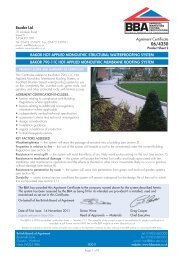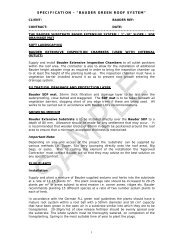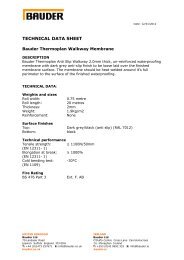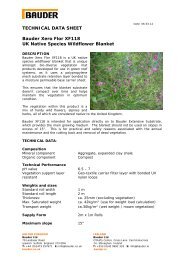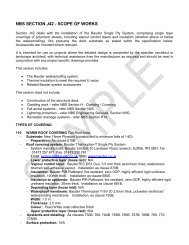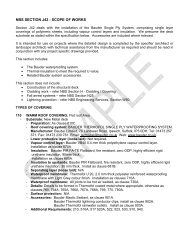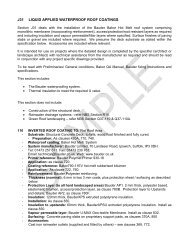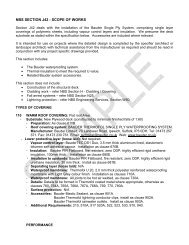The GRO Green Roof Code - SIG Design and Technology
The GRO Green Roof Code - SIG Design and Technology
The GRO Green Roof Code - SIG Design and Technology
You also want an ePaper? Increase the reach of your titles
YUMPU automatically turns print PDFs into web optimized ePapers that Google loves.
<strong>The</strong> tabulated reference values are approximate only, <strong>and</strong> represent some of the key physical properties for<br />
substrates, as derived from the FLL guide (Section 16):<br />
Properties<br />
Reference Values<br />
Depth<br />
Porosity<br />
Pore-size Distribution:<br />
d ≤ 0.063 mm<br />
d ≥ 4.0 mm<br />
Maximum Water Holding Capacity<br />
(MWHC)<br />
Air Content at MWHC<br />
Water permeability<br />
pH value<br />
Organic content<br />
Extensive<br />
Minimum 80 mm<br />
(see note 1)<br />
-<br />
≤ 15% (by mass)<br />
≤ 50% (by mass)<br />
≥ 25% ≤ 65%<br />
(by volume)<br />
≥ 10% (by volume)<br />
0.6 – 70 mm/min<br />
6.0 – 8.5<br />
≤ 65 g/l<br />
Intensive<br />
Typical ≥ 200 mm<br />
-<br />
≤ 20% (by mass)<br />
≤ 40% (by mass)<br />
≥ 45% (by volume)<br />
≥ 10% (by volume)<br />
0.3 - 30 mm/min<br />
6.0 - 8.5<br />
≤ 90 g/l<br />
Note 1:<br />
A depth of aggregate-type material not less than 80 mm is recommended on a green roof installation.<br />
<strong>The</strong>re are, however, certain applications where lesser depths can be used:<br />
1. Where pre-grown vegetation mats are being used, the aggregate-type materials may be reduced to 60<br />
mm average depth plus a minimum mat thickness of 20 mm (FLL 2008, 7.2.1); or<br />
2. Where manufacturers have developed systems for particular applications, providing a more limited range<br />
of benefits, but reducing the weight of the system. [In this instance, designers <strong>and</strong> installers should consult<br />
the manufacturer of these systems to confirm their performance <strong>and</strong> any increased maintenance <strong>and</strong><br />
irrigation requirements].<br />
3.1.6 Vegetation<br />
3.1.6.1 Plant Selection<br />
Key factors in specifying green roof plant layers include:<br />
• Objective: Different plant physiological composition translates into different performance traits. For<br />
example, roofs seeking to improve stormwater retention will often utilize sedum species, due to the water<br />
consumption pattern associated with their crassulacean acid metabolism. Contrarily, a roof seeking to fulfill<br />
a particular biodiversity objective (e.g. habitat creation) may require a specific mix of indigenous species<br />
(often selected by an expert ecologist).<br />
• Plant characteristics: the plant’s architecture (e.g. leaf size, shape <strong>and</strong> coverage) <strong>and</strong> physiology (e.g.<br />
transpiration tendencies etc) will affect the roof’s performance <strong>and</strong> its tolerance to drought, wind, light,<br />
shade <strong>and</strong> pollutants.<br />
• Climate: Variations in sunshine, <strong>and</strong> the resulting differences in solar radiation <strong>and</strong> air temperature, can<br />
affect the length <strong>and</strong> time of growing seasons <strong>and</strong> the risk of frost. Precipitation patterns affect the<br />
dem<strong>and</strong>s placed on the roof by rainfall <strong>and</strong> snow.




